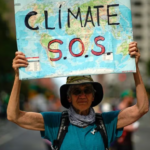NDCs – Nationally Determined Contributions are country pledgesfor reducing emissions and adapting to climate impacts. They are submitted by governments to the UNFCCC.
GLOBAL STOCKTAKE – Under the Paris Agreement’s call for increasingly ambitious emissions cuts, the global stocktake is to be conducted every five years to gauge global progress on limiting warming. COP28 in Dubai will see the first such audit.
UNABATED EMISSIONS – Negotiators are increasingly using the adjective “unabated” before “emissions” to describe carbon pollution not being captured by new technologies such as carbon capture and storage.
PHASE OUT – The gradual reduction in the production and use of fossil fuels. COP26 in Glasgow saw countries commit to phasing down coal use.
MITIGATION – This refers to reducing greenhouse gas emissions to slow if not halt global warming, and is the focus of the global energy transition away from fossil fuels to renewable energy sources.
ADAPTATION – Preparing for or “adapting” to the conditions of a warmer world, including more heat waves and higher sea levels, can include strategies such planting trees for shade or safeguarding supply chains against extreme weather disruptions.
NET ZERO – Net zero does not mean releasing zero emissions, but rather releasing no more than the amount being recaptured by CO2 abatement technologies, tree planting, or other means. Reaching net zero would mean atmospheric GHG concentrations stop increasing. Most countries aim to achieve net zero by 2050.
CARBON OFFSETS – Carbon offset schemes involve compensating governments or companies for investments that generate emissions reductions elsewhere, for example by restoring a forest stand of trees or growing seaweed offshore. Projects that reduce emissions can qualify for carbon credits, which can be sold on carbon markets or used toward bringing down a company’s or government’s reported emissions.
LOSS AND DAMAGE – Governments at COP27 last year agreed to create a fund to help poorer nations already being hit by climate-fueled disasters, but details are still being decided, including who will pay into the fund and how it will be managed.
GREEN CLIMATE FUND – Another fund, established under the Paris Agreement, to disperse $100 billion in annual climate finance from wealthy nations to help developing countries fund the energy transition and projects for adapting to a warmer world.

